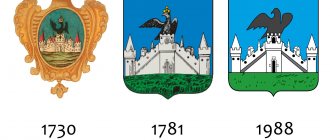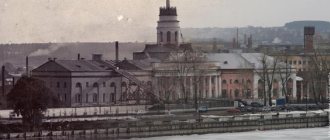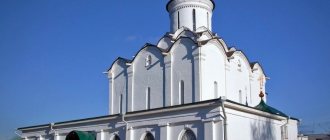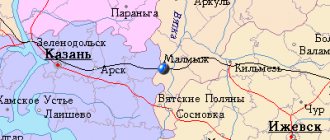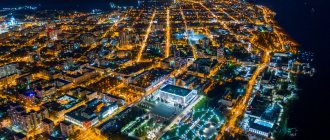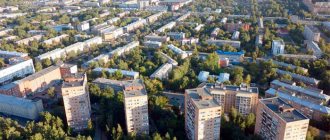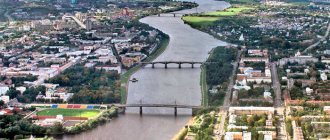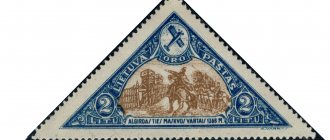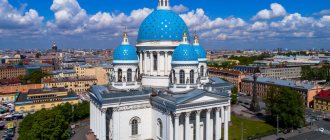What to see in Orel in 1 day
Orel is a rare Russian city that has preserved the fragile architecture of past centuries: monuments, old estates, churches in their original form.
Zlynsky stud farm
The Oryol trotter is known to the world. The famous horse is a living personification of the city itself and Russia. The Zlyn Stud Farm is the cradle of the Oryol breed of horses and the first thing to see in Oryol for tourists. Now it is a museum-estate that is a must-visit. Tourists will be told the history of the breed, be sure to be shown the most beautiful horses, and even be allowed to ride them. In winter there is sleigh rides.
Location: Oryol region, village. Zlynsky stud farm.
Opening hours: all days except Sunday, 9.00-18.00.
How to get there: by bus "Orel - Zlynsky stud farm".
Get directions
Eagle sculpture
A large sculpture of an eagle with powerful wings, a strong beak and a menacing appearance is made from the branches of kochia, a bush similar to a cypress. The sculpture is a symbol of the city and the most popular place for photographing citizens and travelers. By the way, residents affectionately call the proud bird Eagle.
Address: Kromskoe highway, 4.
It’s better to get there by bus 5, 15 to the “TMK Mega Grinn” stop.
Get directions
Train Station
The building, completely different from the station, restored after the Great Patriotic War, is rightly considered the architectural heritage of Orel. Everything is surprising: sophisticated colonnades, as if straight from the drawings of a Gothic temple, high arches. Old chimes play classical tunes instead of the usual strikes.
Address: Station Square, 1, bldg. 1.
Opening hours: 24 hours a day.
You can get there by bus 5, tram 1 to the “Railway Station” stop.
Get directions
Monument to A.P. Ermolov
The famous general of the Russian-Turkish war, a native of the Oryol lands, A.P. Ermolov is immortalized on a mighty horse rearing up. The hero's stern gaze betrays the conqueror of the Caucasus for the glory of Russia.
Location: General Ermolov Square.
It’s convenient to get there by minibus 22 to the “Pervaya Posadskaya Street” stop.
Get directions
State Bank building
The mid-19th century building was specially erected by royal decree of Alexander II. Today it is a striking city building from pre-revolutionary times. The architect achieved his goal by giving the elegant building an ancient Russian style. Towers, kokoshniks, wings and other unusual architectural parts give the bank a unique grace and charm.
Address: Gostinaya street, 6.
Working hours: Monday-Friday, 8.15-17.15.
Travel by bus 35 to the stop “Karl Marx Square”.
Get directions
Monument to Ivan the Terrible
The majestic sculpture depicting the Russian Tsar Ivan the Terrible, sitting astride a war horse, was created in 2021. The Great Tsar points with his hand to where the Orel fortress will be founded, which will later become a large settlement. This is the first monument in Russia dedicated to Ivan the Terrible. The Tsar did a lot for the Russian state, annexing Siberia, Astrakhan, and Kazan.
Location: Epiphany Square.
Get to the monument by bus 55 to the stop “Karl Marx Square”.
Get directions
Composition “Station for tourists”
Attractions for tourists and local residents are unusual compositions, next to which they like to take interesting photos. The ensemble includes the station square of the early 20th century, and next to the standing steam locomotive there is a retro carriage with a sign “Eagle-Paris”, bronze figures of conductors inviting passengers into the compartment. The composition symbolizes the hospitality and cordiality of city residents.
Address: Kromskoe highway, 4.
It’s better to get there by bus 5, 15 to the “TMK Mega Grinn” stop.
Get directions
Epiphany Cathedral
The old cathedral, built at the beginning of the 18th century, due to constant reconstruction, includes three styles at once: Baroque, neo-Russian and classicism. The church survived Soviet times, having been a museum of atheists and even a puppet theater. Today it is a functioning temple, possessing a priceless relic - the miraculous icon of the Most Holy Theotokos “Joy of All Who Sorrow.”
Address: Bogoyavlenskaya Square, 1.
Opening hours: daily, 7.00-20.00.
Travel by bus 55 to the stop “Karl Marx Square”.
Get directions
Monument to N. S. Leskov
A native of the Oryol region, N. S. Leskov glorified his native land, decorating Russian literature with colorful characters. Therefore, the composition consists of the heroes of his stories surrounding the writer: Master Lefty, the merchant’s wife, the pilgrim Flyagin and the old hairdresser. The writer himself is depicted sitting on a bench.
Location: Arts Square.
It is convenient to get there by bus 35 to the stop “Karl Marx Square”.
Get directions
What has changed in Orel over the past five years? In photographs
Over the past few years, Oryol has undergone a major transformation - updated modern urban spaces and places of attraction for residents have emerged. Oryol News decided to remember what has changed significantly in the city over the past 5 years and how much money they spent on it. So, let's go.
The first and serious transformations in Orel began to occur after the city was included in the anniversary program. So, in 2021, a modern embankment appeared in Orel. 340 million rubles were spent on its improvement.
Also, “the most beautiful street in the world” appeared in the regional capital. We are talking about the well-known Lenin Street. The repairs cost the treasury 53.2 million rubles. The inspiration for the renovation was the former chief architect of the region, Vahagn Vermishyan. True, immediately following the results of the repair, many Oryol residents criticized it, and the quality of the repair also caused a lot of criticism. However, the shortcomings were patched up, and the appearance really changed dramatically.
In 2021, Orel entered into the “Formation of a Comfortable Urban Environment” program. And from that moment on, more and more squares and parks began to be renovated in the regional capital. Thus, in 2021, we began updating Botanika Park (2.6 million rubles were spent on stage 1), and in 2021 the transformations continued (5.9 million rubles were already spent).
Also in 2021 and 2021, Victory Boulevard was transformed in two stages. Everything here was beautifully tiled, benches with urns were installed, and a fountain appeared here. The first stage spent 11 million rubles, the second – 26.7 million rubles.
The square was also transformed in 2021. I.S. Turgenev (the so-called “Turgenev’s bank”). Comfortable benches and trash cans were added, landscaping was done - 7.1 million rubles were spent on everything.
Yunost Square was renovated in 2021. From that moment on, people started talking about the “Klychkovo fountains” in Orel, because it was after this reconstruction that more and more “water monuments” began to appear in the regional capital. Overhaul of the fountain, repair of sidewalks, installation of coverings, 7 sets of benches and trash cans - 47.4 million rubles were spent on the work.
The Eaglets square was also cleaned up in 2021. 10.8 million rubles were spent on repairing sidewalks and installing a lawn, installing 29 sets of benches and trash cans, as well as landscaping.
In 2021, the “1001 and 1 little things” square received a new look and a new name – Semashko Square. We spent 5.3 million rubles on repairing sidewalks and installing a lawn, installing 14 sets of benches and trash cans, and landscaping.
The historical and literary quarter was landscaped in 2018. Here, the sidewalks and parking lot were repaired, a lawn and outdoor electric lighting were installed, 18 sets of benches and trash cans were installed, two topiary figures – “Horse” and “Foal” – were installed, 45 trees and 361 shrubs were planted. We spent 14.5 million rubles on improvements.
In 2021, 3.9 million rubles were spent on the improvement of the “Noble Nest” park. Here, the sidewalks of the steps, staircases, rotunda, balustrade and bridge were repaired.
Komsomol Square continues to be transformed this year, although work on the opposite side of the road was completed back in 2021 (then 3.1 million rubles were spent on benches, trash cans and new tiles). The cost of work today is 39.9 million rubles.
In 2021, the improvement of public areas of the regional capital continued. Thus, Orel acquired the square of the 5th Oryol Rifle Division with an original light projection. 41 million rubles were spent on the work.
Also in 2021, the Commonwealth Square appeared with a “dry”, dynamic light and musical fountain. The cost of the work amounted to 87.7 million rubles.
But the most large-scale reconstruction of 2018-2019 was the improvement of the City Park. The fountain and entrance area were also updated here, the alleys were refreshed with new tiles, benches, urns, and lighting. In 2021, 56 million rubles were spent on this, in 2021 – 40 million rubles, and the third stage of improvement is expected in the near future.
Then, in 2021, the Steklomash square was commissioned in Oryol, spending 29.7 million rubles on it. Illuminated trees and swings appeared here... In general, the square really became a place of attraction for the townspeople.
But the most large-scale opening of 2021 was the Children's Park, the reconstruction of which cost 236 million rubles. The townspeople have been waiting for its opening for a very long time. And even despite the coronavirus pandemic, thousands of Oryol residents came to the opening, and today the daily number of visitors is not decreasing.
Where to go as a tourist in Orel, interesting places
The main attractions of the city, which are worth visiting, arose relatively recently, but there are interesting places that have captured the imagination of people for centuries.
Square "Noble Nest"
The park area, where it is pleasant to take a walk, was founded at the beginning of the 20th century. It is dedicated to I. S. Turgenev, as well as the atmosphere in which the writer lived. Everything in the park reminds us of the life of the heroes of the novel “The Noble Nest”.
Not far from Orlik there is an elegant gazebo with white columns - a favorite place for photo sessions of newlyweds.
Address: Oktyabrskaya street, 1.
Opening hours: daily, 9.00-22.00.
Travel by buses 1, 4, 9 to the stop “Institute of Economics and Trade”.
Get directions
Oryol Municipal Drama Theater "Russian Style" named after. M. M. Bakhtina
The modern chamber theater was founded by enthusiasts in 1994. A troupe of actors works in a pre-revolutionary one-story mansion that once belonged to a wealthy merchant. Although the auditorium seats 49, the theater is famous far beyond the city limits. The repertoire is wide: from children's fairy tales to serious classical productions.
Address: Turgenev street, 18.
Opening hours: all days except Monday, 13.00-18.00.
Travel by trolleybus 6, stop "Glavpochtamt".
Get directions
Saburovskaya fortress
The old fortress from the time of the Russian-Turkish war was built in the oriental style by the Kamensky nobles. It consisted of four towers and high stone walls 1.5 km long. Fragments of the fortress walls, towers, and brick buildings inside the fortress are well preserved. There is an Orthodox church nearby that is open to the public.
Location: Saburovo village, 10 km.
Visiting hours: every day, 9.00-21.00.
You can get there by bus "Orel - Saburovo".
Get directions
Museum of Local Lore
This museum is considered the richest in Russia. Founded in the 19th century. Its exhibitions and storerooms contain 160 thousand exhibits dedicated to the life and art of past centuries. The archaeological halls are of great interest to visitors thanks to many historical artifacts.
Numismatics lovers will be attracted by the collection of coins, some of which date back to the 10th century.
Address: Gostinaya street, 2.
Visiting hours: all days except Mondays, 10.00-17.00.
Travel by buses 20, 21, stop “Karl Marx Square”.
Get directions
Seminarsky Park
The monument to landscape art was founded in the middle of the 19th century. It received its name due to the theological seminary previously located here. The park was restored more than once after two wars: the Civil War and the Great Patriotic War. Exhausted by hunger and deprivation, people first of all considered it their duty to bring the pearl of the city back to life. Now this is a favorite vacation spot for Orel residents and its guests.
Location: Seminarsky Park, 1.
Opening hours: daily, 10.00-22.00.
Travel by tram 4, stop "Garazhny Lane".
Get directions
Gostiny Dvor
The first shopping arcades of Gostiny Dvor were built back in the 16th century. It took on its modern appearance from the middle of the 20th century. Now it is a rectangular two-story building in the city center, occupying the entire block. Household items, food, and souvenirs are offered on the first floors of the building.
Address: Komsomolskaya street, 13 B.
Opening hours: every day, 8.00-00.00.
It is convenient to get there by minibus 22, stop “First Posadskaya Street”.
Get directions
Art Museum
Anyone who appreciates beauty should visit the noble mansion with an antique portico, stucco molding and graceful columns. The museum was located here a little over a century ago. The halls contain 1,500 paintings by artists, 200 rare sculptures and thousands of other works of art.
Not every museum boasts a collection of icons of different styles created by masters more than three centuries ago. The collection of traditional Russian porcelain made by old craftsmen is especially delightful.
Address: Oktyabrskaya street, 29.
Visiting hours: all days except Mondays, 10.00-17.00.
Travel by trolleybus 6, stop "Palace of Sports".
Get directions
Museum of I. S. Turgenev
The museum was founded 100 years ago for those who are interested in literature and love the works of the great Russian writer. The halls, equipped as old living rooms, will display Turgenev’s personal items: clothes, books, household utensils, drafts of novels with notes in the margins, made by his hand. There are also many valuable rarities acquired during Ivan Sergeevich’s lifetime, which is what the museum is famous for.
Address: st. Turgeneva, 11.
Opening hours: daily, 10.00-17.00.
You can get there by trolleybus 6 to the Glavpochtamt stop.
Get directions
Theater "Free Space"
The experimental theater was founded by young actors in 1990. Its concept differs from others in that the directors offer a completely unexpected interpretation of ordinary plays. Theater lovers will be surprised by the courage and freshness of the actor's approach to ordinary things, which makes you look at the world in a new way. The repertoire includes dozens of productions for people of different ages.
Address: Karl Marx Square, 2.
Cash desk opening hours: daily, 10.00-19.00.
Travel by bus 35 to the stop “Karl Marx Square”.
Get directions
Collectible Doll Museum
One girl collected factory dolls from all over the world for more than 20 years. When the collection could no longer fit into her city apartment, she decided to open a unique doll museum. The museum building itself looks like a doll's house. Any woman who finds herself in this doll paradise will feel like a girl. The exhibitions are thought out to the smallest detail: clothing, composition depicting this or that action. Near each exhibit there is a card detailing the details.
Various toys are collected: from antique English porcelain dolls in exclusive lace clothes to all kinds of Barbie replicas.
Address: Novosilskoe highway, 6.
Visiting hours: Wednesday-Sunday, 10.00-18.00.
You can get there by bus 15, stop “Yuzhny Pereulok”.
Get directions
Children's park
A huge amusement and recreation park is located on the picturesque shore of Orlik. There are places to go here with children. Vacationers can enjoy quiet walks and wander through the alleys. Fans of active recreation will have a great time on various types of attractions, which are divided into children's, teenagers, and adults. Visitors can enjoy a climbing wall, bicycle paths, a petting zoo, and rental bicycles and roller skates.
Location: left bank of the Orlik River, 21.
Opening hours: weekdays, 9.00-18.00.
Travel by bus 167, stop “Pervaya Posadskaya”
Get directions
Turgenev Theater
Previously, on the site of the modern stone theater building there was a wooden two-story building that served as a stage for the serf actors of General Kamensky. And only in 1815, the completely rebuilt theater received state status. From the middle of the 20th century it began to bear the name of I. S. Turgenev. The writer’s plays are still performed on its stage.
Address: Lenin Square, 2.
Schedule: all days except Monday, 12.00-19.00.
It’s convenient to get there by trolleybus 6, stop “Glavpochtamt”.
Get directions
Shopping center "Mega Grinn"
The city's largest shopping center is a favorite shopping and recreational place for thousands of citizens. The territory includes clothing, cosmetics, accessories, jewelry, and food stores. The visitor has plenty of places to go: the center offers the services of beauty salons, health centers, billiards, and bowling. A cinema with 6 halls, a karting club, a modern trampoline room and food courts will delight you with their new products.
Address: Kromskoe highway, 4.
Opening hours: daily, 9.00-21.00.
It’s better to get there by bus 5, 15 to the “TMK Mega Grinn” stop.
Get directions
Orel city. A story about a walk. Impressions of a tourist from St. Petersburg
This October we made our furthest weekend trip, going as far south as we could, and we reached the city of Orel. We left St. Petersburg on Friday evening, walked there on Saturday, and returned back on Sunday afternoon. The city turned out to be very nice - we came across a lot of old wooden houses, and we also saw a lot of churches of different architecture, and walked along the quiet embankment of the Orlik River. This article will tell you about the impressions the city left and what you saw. We went to Orel by train St. Petersburg - Belogorod. Seated carriages cost 2500, and seated carriages cost 1300, so we went there in a seated carriage. The carriage we came across was brand new, the seats were soft and upholstered in fabric. The carriage was made in St. Petersburg in 2002. The ride is very pleasant. We managed to sleep at night, the seat back reclines, and our legs can be stretched out without any problems. At 9:30 we were at the Orel train station. Exit from the station. The architecture here is very beautiful. Reminds me of the Cameron Gallery in Tsarskoe Selo. The symbol of the city opposite the station. Monument to railway workers. A good sculpture, made with feeling. Nearby there are carriages from the Great Patriotic War. The monument is spoiled a little by the fact that the local authorities stuck Stalin’s name here, because it seems to them that it was necessarily written on every carriage, which speaks not of their knowledge of history, but of their ideas and desires. It is worth recalling that Orel recently distinguished itself by erecting a monument to Ivan the Terrible here - the only tsar who committed the genocide of the Russian people. And the carriage is quite historical - people were transported in them. Railway platform with a cannon and mortar. Tractor with a machine gun. His main task is to pull damaged or stuck equipment out of the field. But if necessary, he could join the fight. Locomotive. And a platform with a truck for Katyusha missiles. “E” class steam locomotives were developed in 1909, during the times of the Russian Empire. Here is an Er series locomotive - they started making them already in the 1930s, so this locomotive actually took part in the Great Patriotic War. But this particular one was built later, in 1951, and until 2021 it worked somewhere in Siberia, until it turned into a monument. Next to the station is the Iversky Temple, which is directly related to the railway theme. The fact is that it was built to the design of an engineer of the Moscow-Kursk Railway, and with funds raised by railway workers. So this church can be considered a temple for railway workers. The church was founded in 1899, consecrated in 1902. At that time, the “Russian style” (pseudo-Russian, neo-Russian) was in fashion, and this church was also built in this style. In 1923 the temple was closed. At one time it housed a railway school. We went inside. A large number of wood carvings caught my eye. Next we had a trip to the most interesting attraction of Orel - the Saburov Fortress in the village of Saburovo. Read the report if you haven't already. And after returning from there, we already went to explore the city itself.
One of the most popular genres among travel bloggers is describing other cities and ridiculing their shortcomings. Especially on this, Varlamov’s pop balabol flourished in his time. Don’t feed a Muscovite bread, but let him mock other Russian cities. It’s like we have such improvement under Sobyanin, but they don’t know how to live, hahaha. Negativity and humiliation of others are always very popular among the public, ratings are guaranteed. In my blog, I initially tried to notice the good in other cities, if possible. Because we need to learn from each other and adopt the best. And now just about this.
I have long noticed - both in Tula and Ryazan - that stray dogs with tags on their ears walk along the streets. No one touches them, no one is afraid of them. Because they are vaccinated, they will not infect dangerous diseases, they are sterilized and are not aggressive. In Orel I saw this most clearly. Dogs friendlyly huddle up to people standing at the bus stop. They play happily on the lawns. No one throws hysterics about dog poop and the supposed danger from dogs, or regularly disperses waves of negativity about animals, as is customary in the capitals. Dogs will prevent wild animals from entering the city, which can bring dangerous infections. Oh, and by the way, trees on the streets are not cut down either, I think this is interconnected. Where they live in harmony with animals, they appreciate nature on city streets. St. Petersburg and Moscow are breaking away from nature, trying to roll everything into concrete, set up ugly high-rise buildings, nature begins to inspire fear and hatred - hence the exaggerated aggressiveness towards animals. This certainly puts pressure on the psyche, which is why we have a lot of nervous, hysterical, depressed and angry people. The phenomenon of mental disorders in megacities has been known for a long time, but I think that separation from nature plays an important role in this - little contact with greenery, animals, birds.
The city of Orel sets an example for us to live harmoniously with the environment, and we should remember what we were like before, learn from smaller cities and return to our roots.
Particularly noteworthy is the large number of lush willows on the city streets. Here is one of them. Real jungle!
But transport cannot be praised. There are almost no large buses on the city streets. Only such small grooves walk. This one has a funny inscription “through Alyosha”, understandable only to locals. All the buses are overcrowded, people travel standing and in a crush, which cannot be considered normal at all. The price is a consolation - going to the suburbs from the center costs only 26 rubles, two times cheaper than in St. Petersburg. But still, transport here is bad. Buses run frequently, but getting a group on them is a problem.
Let's go for a walk along the streets of Orel. Hidden among the modern houses are many ancient houses. Here is one of them, brick. And next to it is a wooden one! Miraculously survived among the kingdom of stone. Stone house. It seems to be pre-revolutionary too. A beautiful house that belongs to “Stalinist architecture” - post-war buildings that imitated the ancient style. Move a little to the side and you can see many wooden houses. Mostly they are small. Many people have a round window under their roof—some kind of local feature. The house still has a courtyard behind a wooden fence, where a gate leads. Everything is just like in the old days. Nearby are ancient wooden doors. There are almost no such places left in St. Petersburg. There are also old houses in various states of preservation. Some look better, some look worse, but there is no devastation among the old houses anywhere, unlike Ostashkov or Vologda, where a significant part of the wooden buildings burned down or collapsed. Some old piece of iron is sticking out. One-story old wooden house. Cozy wooden house. It's probably good to live in this. More wooden houses. A yellow gas pipe goes to the green house. They no longer burn wood there. An ancient two-story house. The lower floor is stone. Another house with a round window that resembles an eye. It is joyful to see the houses inhabited and the streets in good condition. By the way, mountains of garbage, bottles, and cigarette butts are not visible on them, and that’s good! Very beautiful street! The ancient appearance of a provincial town has been preserved here. Small houses do not block the sky, so there is a lot of light in such places. And green trees on the streets provide fresh air. There are a lot of churches in Orel, and their domes are clearly visible above the small houses. You don’t have to think too much about the route, just walk around the city center, and you will always come across some old church. Church of the Life-Giving Trinity and St. Basil the Great. Built during the reign of Empress Elizabeth Petrovna, around 1743. There was a belfry with her, which is now lost. The church was undergoing renovations inside. But it was possible to get into the lower temple. The lower temple was used in winter and is smaller and easily heated. The top one was in the summer, it was not heated. The Cathedral of St. Michael the Archangel is located very close by. There were a lot of cars and people here. It seems that this is a very popular temple in the city. I didn't take pictures inside, it was too crowded. And there is something to look at - many icons, gold frames, a lot of decorations, there was even a statue of Christ. But I took a few pictures outside. The temple was built under Emperor Alexander the First, between 1801 and 1817. Classicism was in fashion then. Every provincial Russian city tried to build a beautiful bell tower, and Oryol was no exception. And this is good, because it allows you to admire the architecture in almost any old city. And bell towers were always built beautifully, because they can be seen from afar. The only shot I took inside. It gives some impression of the beauty and luxury of the cathedral. We walk along the embankment of the Orlik River, which flows towards the Oka River, so that it will soon connect with it. The embankment has been cultivated and is pleasant to walk along. Aleksandrovsky (from 1919 - Leninsky) bridge. Built in 1880 under Emperor Alexander II. It was blown up by the Germans in 1943 and rebuilt after the war. There was vehicular traffic on the bridge, but by the 2000s it had become dilapidated and was restored, after which it became pedestrian. And this is actually very cool - it fits perfectly into the pedestrian promenade space. True, the locals don’t just walk here. But they also paint it with inscriptions from all possible sides. What a sad staircase overgrown with grass. Cultivation and ennoblement have not yet reached here. I went to look at the monuments near the embankment. This is a monument to the writer Leskov, who lived in Orel. And this handsome man is General Ermolov, the conqueror of the Caucasus. Beautiful monument! And fits harmoniously into the square. Well, this evil old man, who for some reason is swinging a cross, awkwardly sitting on a small horse, is Tsar Ivan the Terrible. He is sharply different from the handsome and brave Ermolov, even in appearance. And even more so internally. Ermolov fought defending Russian lands from the French, then conquered the Caucasus, expanding the Russian Empire. And Ivan the Terrible lost the Livonian War to smithereens, lost the original Russian lands, and also carried out massacres in ancient Russian cities, his guardsmen killed hundreds of women and children, the lands were empty, Volkhov was red with blood. A degenerate tsar, to whom no one erected monuments in the Russian Empire, but the current government considered this possible. Which says a lot about the appearance of modern governors. Beautiful architecture. A rotunda gazebo on the other side of Orlik. There are not enough benches on the embankment; there is nowhere to sit. You can't really sit on granite in cold weather. But it's quite good for summer walks. Let us draw your attention once again - there is almost no garbage, although irresponsible youth here and there tweet something. A pedestrian bridge appeared in the distance. It's suspended. Built in 1967. Someone spoiled the view with an advertisement, which left a stub with a phone number. They also tried to stick something on the bridge supports. Paper advertisements, which have long been almost non-existent in other cities, are still found here. Dam on the Orlik River. Erected in 1967. Its purpose is unclear. Perhaps they did it just for beauty, so that there was an artificial waterfall under a beautiful pedestrian bridge. Waterfall, bridge and temple in the distance. Beautiful landscape! Cathedral of the Epiphany. Built in 1642-1646. This is the time of the reign of the very first tsar from the Romanov dynasty - Mikhail Fedorovich. At that time, Orel was not yet an ordinary city, but was a border fortress that had not yet lost its military significance. In 1837-1838, the temple was significantly rebuilt and expanded, hence the classical style. During Soviet times, the temple was closed twice; it was finally returned to the Orthodox in 2015. This is the oldest temple of Orel. The historical place is the confluence of Orlik and Oka. It was here that the Orel fortress was founded to hold back the raids of the steppe hordes of the Crimean Tatars. This happened in 1566. Then a network of small fortresses appeared - outposts, which sent signals to Moscow about the approach of an enemy army. And if possible, they tried to delay him until reinforcements arrived. This process continued under Boris Godunov, who founded several powerful fortresses; under the first Romanovs, abatis lines were built from trees, which were a barrier for the mounted army - much like the lines of anti-tank barriers were made in the 20th century. It became more and more difficult for the steppe inhabitants, who under Ivan the Terrible could easily burn down all of Moscow, to attack. Their aggression was finally stopped under Princess Sophia, when two campaigns of Prince Golitsyn took place, who could not take Crimea, but repulsed the desire to attack Russia. Under Empress Anna Ioannovna, the process was completed - Russia for the first time captured and destroyed Crimea, and there was no one else to attack us from there; soon Crimea became part of the Empire (under Catherine the Second). And the story of the confrontation with the Crimean Khanate began here. Monument to the liberators of Orel. Another example of Stalinist architecture, which imitated the ancient style. They write that this house was built using the foundations and walls of older houses that survived the war. Well, we crossed the Oka over the bridge. And they moved to the outskirts of the city. On the other bank we also came across small wooden houses. Another beautiful temple. This is the Akhtyrsky Cathedral. The church was built in the 1770s, the bell tower in the 1820s. It is interesting that, like the previous cathedral, this one was closed in the 1930s, when Stalin carried out a real massacre of priests, exterminating almost everyone throughout the country, and churches were also closed en masse. When the city was captured, both temples were reopened. When the city was liberated, it was inappropriate to close the churches a second time, so as not to spoil the joy of the liberation, and therefore they remained in operation. Railway bridge over the Oka River. We reached a cave on the banks of the Oka, where stone had previously been mined. Unfortunately, the cave turned out to be higher in difficulty than we thought. They climbed inside and crawled around the first room, where you could only sit, but not stand.
And then, into the labyrinth, there was a narrow hole where you had to climb about five meters. It is obvious that they climb here often and that further on there is a large dungeon. But I couldn’t afford to climb the narrow skinny path - it would take a lot of time, especially considering that I’m not very narrow... So we looked and went back. This is what the entrance to the quarries looks like. We walked back past the Holy Vvedensky Convent. But it was already dark, and we couldn’t photograph anything except the turret of the fence. At the station we went into a store. A happy local cat was sitting here. I bought him a bag of food, but when I came out, he was already eating a huge piece of meat that someone had treated him to. Once again we were convinced that in Orel they treat pets well. This means that good people live in the city. He who knows how to sympathize and care for the weak has harmony in his soul. The station is beautifully illuminated at night with the colors of the Russian flag. We went back in a reserved seat carriage because we needed a table for a mass tea party with cakes. Early in the morning the train stopped at Bologoye station, and I got out to get some air. And at the same time take a photo of the local steam locomotive in the morning light. This is where our journey ended. Original
Beautiful places in Orel that are worth visiting
The Oryol region is rich in historical sights and untouched natural beauty. True Russian nature and famous places full of folk cultural traditions arouse the genuine interest of travelers from all over the world.
Oryol Polesie National Park
The protected areas of the national park occupy a vast territory. Here, Polesie, which has preserved its uniqueness, combines amazing nature and the historical heritage of the people.
There is no need for a tourist to visit Belarus to see a live bison. The giant bull also lives here, in the Oryol region. Experienced guides will help you walk along a comfortable ecological path to see this interesting miracle of nature. The park's areas include forested areas equipped with recreation areas, an open-air zoo of rare animals and birds, archaeological monuments, the Radovishchi settlement, and an old village. It's interesting to walk there.
Location: village. Zhudersky.
Opening hours: every day, 10.00-17.00.
You can get there by bus “Orel - Khotynets”, then by minibus to the stop “Usadba Polesya”.
Get directions
Source of Saint Kuksha
In the old days there lived Saint Kuksha, who preached Orthodoxy in the Oryol lands. The idol worshipers killed the saint. At the place of Kuksha’s death, a miraculous spring began to flow. Later a monastery was built and the spring was improved. Finding the source is easy. Wooden paths lead to the spring, a font is equipped, and a small church is built.
Location: village. Mtsensk.
You can visit the source 24 hours a day.
Travel by bus 128 to the Frolovka stop.
Get directions
Kuznetsovskie ponds
The townspeople's favorite vacation spot spreads over 25 hectares. Shallow ponds are rich in carp, grass carp, crucian carp, perch, and pike. They are separated by sectors for fishing and recreation. Picturesque places and sandy beaches have long been loved by local residents. Despite the active visitation by vacationers, free recreation areas - gazebos, tables, barbecues and bridges - are kept clean.
Location: Bolkhovsky district.
You can get there by bus "Orel - Kuznetsovsky".
Get directions
Cave "Water"
Thrill-seekers will find something to visit in Orel. The old cave is located within the city. The height of the ceilings of the former quarry is from 1 to 3 meters. The depth of underground lakes is up to 3 meters. The water is absolutely clear. Some places consist of clay islands. Others are completely flooded. Therefore, it is important that tourists are accompanied by an experienced speleologist. They travel around the cave only by boat.
Location: right bank of the Oka River, 500 m from the pier.
Excursions are possible during daylight hours.
Travel by tram 4, stop “Moldavskaya”, then walk to the pier or by car.
Get directions
Regular plan for the development of the city of Orel in 1779. "Doplanovo" churches.
The redevelopment that began in Orel in 1779 ( which I wrote about here ) significantly changed the appearance of the old city. At the same time, much of what was in the city before, in “pre-Plan” times - historically developed streets and alleys, wooden and stone houses of the townspeople - was destroyed. Much, but not all. After more than two hundred years, it is very difficult to figure out what survived and what did not. However, the obvious fact is that even today there are still buildings in Orel whose history goes back to the distant “pre-Plan” times. First of all, these are, of course, temples. According to a brief description of Orel made in 1778, a year before the appearance of the regular plan, the city had 17 stone churches and one wooden one. Also in Orel there already existed two monasteries - male and female, and three recently founded city-wide cemeteries. The redevelopment of the city did not require the demolition of any of the then existing churches and monasteries. New streets and squares were laid out taking into account their location. You don’t have to be an expert on Oryol history to understand that not all of the “pre-Plan” churches have survived to this day. In modern Orel, which is several times larger than Orel at the end of the 18th century, there are not 18 churches even together with new-built churches in residential areas. Of the churches that were in the city at the time the plan was created in 1779, some were destroyed during the Soviet years, but most ceased to exist in the 19th century. The location and history of each of these temples is well known to us. Among the temples mentioned in the description of 1778, only five have survived to this day. Among them is the oldest building in the city of Orel - the Church of the Epiphany, created at the end of the 17th century on the spit of Oka and Orlik.
View on Yandex.Photos 1
View on Yandex.Photos 2
True, then it looked a little different than it does now - with a bell tower, bright red walls and carved white stone decoration (which was knocked down in the 19th century during the renovation and expansion of the temple).
View on Yandex.Photos 3. Reconstruction - drawing by V. Nedelin from the book “The Primordial Eagle”.
Next to it, on the spit, the old Nativity Cathedral, built in the 1730s, was then located. But it remained there for less than 10 years, and soon it will be dismantled due to its disrepair. In 1777, its bell tower, which was in danger of falling, was already dismantled.
The second of the oldest buildings in Orel is the Trinity-Vasilievskaya Church, built in 1743-51. Taking into account its location in the city plan, the existing 2nd Posadskaya and Vasilyevskaya streets were planned.
View on Yandex.Photos 4. The photo is taken from the book “The Eagle Yesterday and Today.”
However, in reality, not everything turned out as successfully as on paper. For some reason, Vasilievskaya Street was not laid out as planned, and the corner of the altar part of the church blocked it by a third at the intersection with 2nd Posadskaya. This location of the temple has repeatedly caused various troubles; in my memory, cars have crashed into the corner of the temple several times.
View on Yandex.Photos 5
The remaining three of the “pre-Plan” churches that have survived to this day were only in the process of construction in 1778. The Church of Elijah the Prophet, better known as Nikolo-Peskovsky, will be completed only in 1790, but 14 years before the end of construction, services were already underway there in one of the side chapels. Taking into account the location of this temple, Voskresenskaya and Nikolo-Peskovskaya (now Gagarin and Normandy-Neman) streets were laid out, at the intersection of which it stands.
View on Yandex.Photos 6
View on Yandex.Photos 7
But as you can see today, there was also a curiosity here - the straight and wide Nikolo-Peskovskaya Street literally abuts the Ilyinsky Church and, going around it, narrows in half.
The Akhtyrskaya (Nikitskaya) Church, on what is now 5th August Street, was also still under construction in those years.
View on Yandex.Photos 8
Unlike the churches I have already mentioned, it was not a parish church at that time, but a cemetery. In the place where it still stands, in 1772, one of the three new city-wide cemeteries was founded. However, after 14 years, its location was considered unsuccessful and was moved away from the city center to the modern area. The Akhtyrskaya church was made into a parish church, and new streets were laid on the site of the cemetery.
But another one that existed in those days - the Baptist Church, built in 1772, has remained a cemetery to this day.
View on Yandex.Photos 9
In 1778, all three churches looked somewhat different than they do now, without bell towers or refectories, and completely miniature.
Three “pre-Plan” churches survived the 19th century safely and were destroyed during the Soviet years. Their appearance is depicted on several old postcards and views of the city. The ancient Boris and Gleb Church, like the Akhtyrsky Church, began to be built in 1776 as a cemetery, and a few years later it was made a parish church.
View on Yandex.Photos 10. The photo is taken from the book “The Eagle Yesterday and Today.”
It was located on the street now named after Saltykov-Shchedrin, in the place where the police department's clinic is now located.
Two more churches were monasteries. This is the Vvedenskaya Church of the old convent, which stood on the site of the current Trud printing house.
View on Yandex.Photos 11. Photo taken from the book “Oryol Province. Pages of the photo chronicle"
And the old Assumption Cathedral of the monastery, one of the last to be destroyed in the city, in the 1980s. This is what he looked like originally.
View on Yandex.Photos 12. Reconstruction - drawing by V. Nedelin from the book “The Primordial Eagle”.
And so at the beginning of the twentieth century.
View on Yandex.Photos 13. Photo from the book “The Primordial Eagle.”
The remaining 9 of the 18 churches were dismantled back in the 19th century, giving way to other, more spacious and luxurious church buildings, built by parishioners in their former places. We know almost nothing about the appearance of many of these 9 “pre-Plan” temples. One of the first, at the end of the 18th century, to go into oblivion was the last of the wooden churches of the “pre-plan” Orel - Nikolskaya, which once stood at the intersection of what is now Rynochny Lane and Cherkasskaya Street. It was replaced in 1797 by a new stone church known as St. Nicholas the Fish.
View on Yandex.Photos 14. The photo is taken from the book “Oryol Province. Pages of the photo chronicle"
But this temple has not survived to this day. Now there is no temple in this place, just as there is none in Voskresensky Lane, where the church of the same name once stood,
View on Yandex.Photos 15. Photo taken from the book “Oryol Province. Pages of the photo chronicle"
on Pokrovskaya Street, in the area of which there were two churches, Pokrovsky and Pyatnitsky (later Preobrazhensky). This is what the old pre-Planovsky Church of the Intercession of the 18th century looked like.
View on Yandex.Photos 16. Reconstruction - drawing by artist V. Romashov taken from the book “Architectural Antiquities of the Oryol Region (bygone). Book two."
View from the early 20th century.
View on Yandex.Photos 17. Photo taken from the book “Oryol Province. Pages of the photo chronicle"
on the former Vozdvizhenskaya (Polikarpov) Square
View on Yandex.Photos 18. The photo is taken from the book “Oryol Province. Pages of the photo chronicle"
and Georgievsky Lane.
View on Yandex.Photos 19. Photo taken from the site https://www.orel-story.ru
In all these places in 1778 there were ancient temples, and when the plan was developed, the streets and squares surrounding them were named in their honor. Then, in the 19th century, they were replaced by new, more spacious church buildings, and in the 20th century, the ancient places of worship were empty.
Only two churches of the 19th century, built on the site of “pre-planning” ones, have survived to this day - St. Michael the Archangel and the Smolensk Icon of the Mother of God. On the site of the current Michael-Arkhangelsk Church, on the Right Bank of Orlik there were even two small stone churches - the Assumption and the old Michael-Arkhangelsk.
View on Yandex.Photos 20. Reconstruction - drawing by V. Nedelin from the book “The Primordial Eagle”.
View on Yandex.Photos 21
In 1801, one large temple was built at the expense of the parishioners of both churches. The parishioners of the old Church of the Smolensk Icon of Our Lady, which once stood in the middle of what is now Normandy-Niemen Street, did the same. Built in place of the old one, the new Smolensk Church is the largest in Orel and for some time was even the main city cathedral.
View on Yandex.Photos 22
This is the history of the most famous and notable of the “pre-Plan” buildings of Orel. In addition to them, after the redevelopment of 1779 in the city, a number of houses of the townspeople also survived. But, unlike temples, we know practically nothing about the surviving “pre-Plan” secular buildings. And yet, even today houses with a “pre-Plan” history can still be found in the city.
To be continued.
Thank you for your help and the materials provided for this and subsequent articles in the po_orlu .
Sources:
https://www.orel-story.ru
“Architectural antiquities of the Oryol region (gone). Book two." – Orel: Spring Waters, 2009.
"Eagle yesterday and today." – Eagle: Spring waters. 2006.
"Churches and monasteries of the city of Orel." – Eagle: Folio, 1998.
Emelyanov. V.G. “Streets of the city of Orel. History of names". Directory. – Orel, 1986.
Nedelin V.N. "Primordial Eagle" – Eagle: Spring waters. 2001.
Lysenko A.I., Titova V.V. "Oryol province. Pages of the photo chronicle” – Orel: Spring Waters. 2012.
PS Well, as usual, if anyone reading my post finds any errors, inaccuracies in it, or anything written seems strange or incomprehensible, please write about it in a comment. I will be very grateful.
Original
